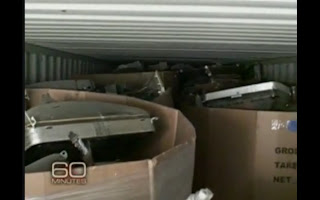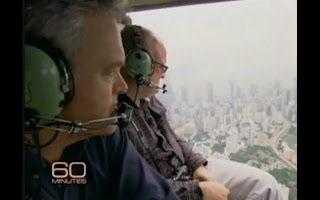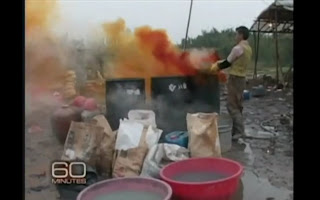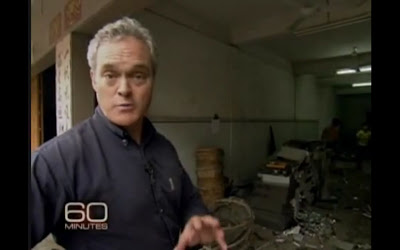I've previously written a nerdy piece on the 8 minute CBS 60 Minutes Documentary, "The Wasteland". There are certain very good things about it, and WR3A members like that it raises the bar on bad "ewaste" recycling practices.
The intent of this post is to point out where CBS did well, but also focus on where they made a major, major blunder. One they have yet to correct. I have inserted the "ommissions" and my commentary in pink.
In the opening scenes they show computer collection at a one day event in Denver. They show people waiting in line and making an effort to do the right thing.
 Then, they interview the USA recycler, who actually invokes BAN images of the awful export market, to make people feel good about using his company's services. This appears to be a gross lack of transparency... the guy is apparently pushing the recyclers overseas under the bus while he himself is shipping containers full of junk. [update: He was later convicted of fraud, not of dumping]
Then, they interview the USA recycler, who actually invokes BAN images of the awful export market, to make people feel good about using his company's services. This appears to be a gross lack of transparency... the guy is apparently pushing the recyclers overseas under the bus while he himself is shipping containers full of junk. [update: He was later convicted of fraud, not of dumping]My role? CBS News representatives Michael Rey and Nichole Young spent about an hour trying to do due diligence before the story ran. They didn't disclose what they had filmed in China, but they were calling to make sure they did not accuse a good operation of bad practices. On the evening of the broadcast, I got to text with the producer, Solly Granatstein. I had to say that it looked to me like they caught an actual bad guy, and Solly said back "thanks, you've made my day". [*But I had always told them, the CRT market in China was for reuse and refurbishment - those were never sent to Guiyu, and they would not find many CRTs in Guiyu China.]
CBS showed images of the inside of this guy's containers. He would appear to fully flunk the "CRT Glass Test" (something BAN and I worked on together back in the good times).
The junk CRT is the most expensive and, as 60 Minutes identifies, the most regulated and toxic component - and they are clearly visible on the back of the guy's container.
So far, the documentary is doing great, exposing shortcuts and hypocrisy [and apperently, "toxics along for the ride"].
 However, I had specifically gone over the economics of shipping junk with CBS News. Admittedly, the math (like I tried to do in the "Zoo" blog) can make eyes glaze over, and it's hard to see eyes a-glazing on a telephone interview. But I explained that normally, there needs to be something good on the container. It cannot be all "toxics along for the ride". And I specifically described the SKD factories [and shared photos from "Big Secret Factories"] as being the thing China had which was way more sophisticated than anything in the USA (except for Video Display Corp.) I have shown CBS images from WR3A visits to Contract Manufacturing facilities, including factories in Guangdong.
However, I had specifically gone over the economics of shipping junk with CBS News. Admittedly, the math (like I tried to do in the "Zoo" blog) can make eyes glaze over, and it's hard to see eyes a-glazing on a telephone interview. But I explained that normally, there needs to be something good on the container. It cannot be all "toxics along for the ride". And I specifically described the SKD factories [and shared photos from "Big Secret Factories"] as being the thing China had which was way more sophisticated than anything in the USA (except for Video Display Corp.) I have shown CBS images from WR3A visits to Contract Manufacturing facilities, including factories in Guangdong.It's difficult to spot, but there are some intact white monitors visible in the back of the container. Possibly, the dude is piggy-backing the bald scrap CRTs on a good CRT shipment. Hopefully he wasn't paying for the waste with printed circuit boards, a little bit of which can pay for a lot of TAR.
National Resources Defense Council (NRDC)'s Allen Hershkowitz is interviewed about the toxics which are potentially on board in electronics [in Brackets, he will later go on - outrageously - to denounce one of the best refurbishing factories in the world, in Indonesia, as a "primitive, wire burning" operation]. I would try to agree with NRDC, though it's also important to discuss the full lifecycle - to balance the toxics employed in mining processes (cyanide and arsenic), in production processes, in recycling processes (aqua regia), and entombed in the "ewaste" product itself (cadmium in1960s CRTs, mercury in batteries).
Then it's off to Hong Kong. What I find interesting is that CBS reporter Scott Pelley is standing in one of the most sophisticated, large, high-tech, wired, and wealthy cities in the world, but makes no transition from the high tech monorail ride to the plinky-sounding bikes in Guiyu. Here is where something starts to smell. CBS is just miles away from Foxconn, a factory campus with 279 thousand employees, which produces iPhones and laptops and virtually everything the story is about.
 In Hong Kong, CBS's Pelley rides a helicopter with Jim Puckett of BAN, and they circle thousands of CRT computer monitors. At this point, Jim Puckett knows, or should know, that no CRTs go to Guiyu. At this time, CBS has been informed about where these monitors go.
In Hong Kong, CBS's Pelley rides a helicopter with Jim Puckett of BAN, and they circle thousands of CRT computer monitors. At this point, Jim Puckett knows, or should know, that no CRTs go to Guiyu. At this time, CBS has been informed about where these monitors go.Do they not connect the dots? Did BAN intentionally withhold information?
Hong Kong is actually a huge generator of CRT monitors in its own right, so whether these were even imported or not is
The question is, where are these monitors going?
It is NOT to GUIYU. No dagnab way.
 In an open letter to BAN, I have explicitly defended the "Big Secret Factories". Equating these with Guiyu is like equating Barack Obama or Colin Powell to a Chicago gang member. [Same race, different "profile".] They are much larger and more important than the little "wire burning" villages, create good jobs, and are actually better than any recycling operation which exists in the USA today. Yes, they are owned by someone of a different nationality. Get over it!!!
In an open letter to BAN, I have explicitly defended the "Big Secret Factories". Equating these with Guiyu is like equating Barack Obama or Colin Powell to a Chicago gang member. [Same race, different "profile".] They are much larger and more important than the little "wire burning" villages, create good jobs, and are actually better than any recycling operation which exists in the USA today. Yes, they are owned by someone of a different nationality. Get over it!!! Companies like Proview, BenQ, Foxconn, Wistron and Viewsonic were the manufacturers of CRT computer monitors, as contract assembly operations for IBM, HP, DELL, GATEWAY etc. throughout the 1990s. I told CBS producers that I had personally visited huge CRT assembly plants in Guangdong province, and I used to ship there 5 years ago (that's how I got invited, I wanted to visit).
THIS SLIDE SHOW SHOWS WHO BUYS THE MONITORS IN HONG KONG. IT INCLUDES SLIDES FROM CHINA, INDONESIA, MALAYSIA AND THAILAND. [It was shared with CBS 60 Minutes producers, and with Basel Action Network]
The old CRT monitor assembly factories survive today mainly by refurbishing older monitors. I provided some of this film to CBS. The original post, Big Secret Factories, appeared 18 months ago, and BAN has still not responded to the reminder letter posted last April. These factories probably won't be doing CRT refurbishing many years longer, and are trying to get into LCDs contract manufacturing already, but there is lots of competition in northern China for that manufacturing base. So for now, they do what they do well, but cheaply - they buy CRTs and rebuild them for resale into the "good enough"
The factories like those in these photos import tens of thousands of computer monitors per DAY and professionally refurbish them in the same factories that originally made the computer monitors for Dell, HP, IBM, Gateway, etc.
Returning to CBS 60 Minutes, Scott Pelley says, in the infamous quote, "We followed the trail..."
The trail of monitors in Hong Kong? The trail of Executive Recycling's containers? The trail of WHAT?
To Guiyu, a circuit board and wire burning village? Gee, of the tens of thousands of monitors you circled in Hong Kong, about how many CRTs did you see in Guiyu, China? Were they in that van up ahead (that's what's on screen when he says "followed the trail").
Here is where reporter Scott Pelley demonstrates he is on thin ice. He picks up a plastic monitor stand, and says that obviously they are demanufacturing monitors here as well. Jim Puckett is in the shot, but does not appear to correct him, or inform him about the CRT SKD factories we quarrel so vigorously over in the Basel Convention Annex IX section B1110 debate.
Pelley's trip through Guiyu turns up a lot of sad and ugly stuff, and when I show the super sophisticated contract manufacturing factories, I have sometimes been accused of trying to "cover Guiyu up". They are both there, just like you have all kinds of people doing all kinds of things in America. I admit, I must be careful with whom I share a church pew. So I'll be sure to show some of the ugly stuff here as well.

Melting solder off of boards to harvest (reuseable) chips and capacitors (these get shredded in the USA and go out with the fluff to a landfill... we need to invest in a compromise)... Not an acceptable electronics recycling practice.
Here, according to CBS, is a mideval process for precious metal recovery. I presume it's aqua regia, which I've written about extensively. WR3A has a zero tolerance for circuit board recycling in primitive operations.
The Gold Test or Printed Circuit Board Test is a do not pass go, do not collect $200 issue for WR3A recycler memberships. I've written about some of the things driving it - women's rights to own land. I'll just leave here that it's not only polluting and dangerous and ugly, but its not even good recycling - they throw away a lot of the gold and silver and all of the precious rare earths like rhodium. It's a disaster. There were no PCs or computer circuit boards visible on the sea container from Colorado... but it would not take very many of them to pay for a lot of TAR, which is why WR3A agrees with BAN so very strongly on this practice.

The practice at left, harvesting capacitors and chips and ringy-dingies off of heated circuit boards, is again somewhat complex. If you did a thorough lifecycle analysis, arguably fewer people are poisoned, and less poison is produced, by reusing electronics components in this method than shredding them in the USA and mining and refining and producing new ones from scratch. And it's kind of sophisticated too, to see people trained to identify unique small parts for reuse. [New: Independent reporter documents that pay in these jobs is good, typically higher than Ph.Ds earn. The job is to make it safe]
My position is that, seeing the children sorting them... it's heartbreaking. In the interests of transparency you have to be totally honest if this is what you are doing... and I'm not willing to defend it at this stage. My company does not send boards to places like this (we use Colt or Sims, and send monitors for demanufacturing to audited markets as well).
Below is the photo that kind of says it all.
Scott Pelley stands in a garage sized tinker-toy operation, and describes it as the "tidy little facility", the example of high tech recycling which the Chinese officials "want us to see".
Having been within a train stop of Shenzhen and Foxconn, which is already doing high end recycling for HP, he is either willing to stick a fabricated storyline to close the deal,
What made the story worth Scott's willingness to "close one eye"? My dad, Bill Ingenthron, is a retired journalism professor from the University of Arkansas, who got his degree from Columbia Missouri (top notch J school). He always said that the biggest risk to good journalism was the by-line, which despite the transparency it offers (reporters being accountable), is too tempting to journalists.
 If the reporter becomes "a part of the story", the facts and the ego become saturated and entwined. Le Monde does not have bylines.
If the reporter becomes "a part of the story", the facts and the ego become saturated and entwined. Le Monde does not have bylines. CBS likes the story of its reporters risking their necks.
At the end, CBS's Scott Pelley nearly redeems himself, in a face to face with Jim Puckett.
Scott Pelley explains that the Chinese he interviewed here did not want to lose their jobs, and that they need their jobs.
Jim makes the remark I devoted a blog to in 2009, titled "We shouldn't have to make that Choice". Jim says the Chinese should not have to choose between "poverty and pollution", in a double alliteration that Pelley provides as punctuation.
The jobs we are fighting over are not the jobs in Guiyu. They are the jobs at the monitor manufacturing factories, which make "ewaste" recycling affordable for Americans, and make display devices affordable for the developing world, which is starving for internet and cannot afford a $100 LCD monitor.
Did 60 Minutes have time to show the good side of the refurbishing business? Did they have time to show the factories where the monitors really go? 60 Minutes had time to film the clownish "tidy" facility in that spot, and they had time to show TWICE the reporter's heroin - the cameraman being attacked for exposing a story. As a result of this story, and as a result of BAN's silence, e-waste recycling is more exponsive in America, there is more mining done in Africa and Asia, and Egyptian medical schools cannot afford monitors for their students.
A crime has indeed been committed. But in order to expose the environmental crime, CBS and BAN have allowed racial slander and stereotyping to stand, and it has been almost two years without a correction. Did Pelley really care about the jobs and the poverty?
The danger of letting the reporter get "sexy", as Pelley does in the "take our cameras away" segment provided in two places in the documentary, is that they miss a small turn in the story and don't want to return and get it right at the risk of losing their Polk Award.How do we steer this thing back to Fair Trade Recycling practices? How can we get electronics to the people who can do it best, adding the highest value through reuse and repair, creating sustainable and green jobs in countries that need them? How can we eliminate "toxics along for the ride", without throwing in the towel to mining extraction? I don't want a bouquet of I-told-you-sos. I want good people at NRDC and good people at BAN to sit down again with John Lingelbach of R2 and EPA, and the United Nations. Get Tom Friedman, who would understand what I've been explaining in an instant... he's pals with Kennedy at NRDC. Get Joshua Mailman, funder of BAN, and the OEMs together. Asia has outgrown CRTs anyway, we can move the entire SKD factory to Mexico if BAN will support that.
[ed. For more details on the ignored market, see 2011 Motherboard.tv Article].
I have been making these entreaties since 2001. I only get any attention by telling the truth publicly. I can't seem to get financing to do Fair Trade Recycling the way I want to, despite support from EPA and Investors Circle and Forbes, NPR and PBS, and a come-here-gettaway tease from EPA Border2012. I am trying to hold out for a financing partner who "gets it", who won't put a gag in and sign a no-export pledge, and who won't play the high profitability game of Toxics Along for the Ride. [Patient Capital is hanging out with the Tooth Fairy and Santa Claus]
This is an appeal for help. As John Adams sang in 1776, "Is anybody there? Does anybody care?" As John Adams sings, I've crossed the Rubicon.















9 comments:
I care. But I can't have my business exposed to these accusations. We cannot export until the environmental community creates a window to do it in.
They had all the paper work to prove it, and it was sitting right there in the the shipping container. They followed the ship w/that contained the shipping container, and saw the junkyard there full of illegally shipped and illegally stored CRTs..
Obviously YOUR article did not disprove anything actually.. All that it did was just raise some frustrating suspicion..
The company sold those monitors to Hong Kong. It was right there in the paperwork man. The CRTs were sitting right there.
Are you paranoid at all? Good try though I'm sure you have somebody out there convinced.
And I re-watched Ewasteland for the 3rd time, once again after reading your article, according to my observations you're quite inaccurate about this thing.
Chill pill man.
Eimos,
It sounds as if you believe the CRT monitors are processed in primitive conditions in Guiyu. I think it would have been better journalism to acknowledge the clean factories refurbishing on an industrial scale, and may have shown fair trade to be a better solution than a prohibition. The blog does not defend the junk along for the ride in the container. Inaccurate? Do you think these factories don't exist? Stay tuned. https://picasaweb.google.com/ingenthron/ContractCRTManufacturersAlbum?feat=directlink
Your article makes sense, however you didn't respond to the GAO's findings that the company was willing to sell to China
There are two or three issues here.
First, the GAO Study found that several companies were willing to sell to China. The problem with that GAO study was that they offered to pay $10 for broken glass tubes, something that doesn't occur in the free market. Prices paid for those tubes (at factories like the ones I have visited) specifically excluded broken, and in fact were picky about size, raster, etc.
But second, I am not trying to defend the specific USA exporter in the CBS sting. I found his load to be crap, as I say in the beginning of this article.
What I object to is 3) the failure of CBS to follow the lead specifically given to them before the episode ran, to visit the actual factories that actually purchase computer monitors in the Hong Kong (helicopter) segment. The good factories must buy from bad suppliers.
The episode exacerbates that problem by painting a primitive picture of the Chinese refurbishing market.
Hong Kong was and is a conduit into China. When the US was not officially selling to China, things went through Hong Kong. When supercomputers are not allowed to go into China, they go through Hong Kong. You must be delusional if you think that Hong Kong is the entity that ships all that CRTs to China or generates that much. Are they changing their monitors every year?
If the shipping container was mostly empty crt screens with the exception of one, then why did HK customs send it back to CO with big old CRT waste stamped on it?
WR3A's Robin Ingenthron said...
Thanks for your comment. Reread the article, or if you prefer, I have some shorter ones. The point is that MOST of the monitors imported are refurbished in factories, and MOST of the ones disposed are domestically generated. CBS never went to the factories pictured above, and did not mention them. Factories in HK were importing 50,000 CRTs per DAY in 2006, for factory refurbishing in the original contract manufacturing factories which originally made the monitors, and no monitors or CRTs are found in Guiyu. CBS and BAN said that 80% of USA e-waste goes to Hong Kong for primitive disposal. It's wrong. They say they are "following the trail". Where were the monitors in Guiyu? http://www.motherboard.tv/2011/3/31/why-we-should-ship-our-electronic-waste-to-china-and-africa
November 30, 20
Post a Comment